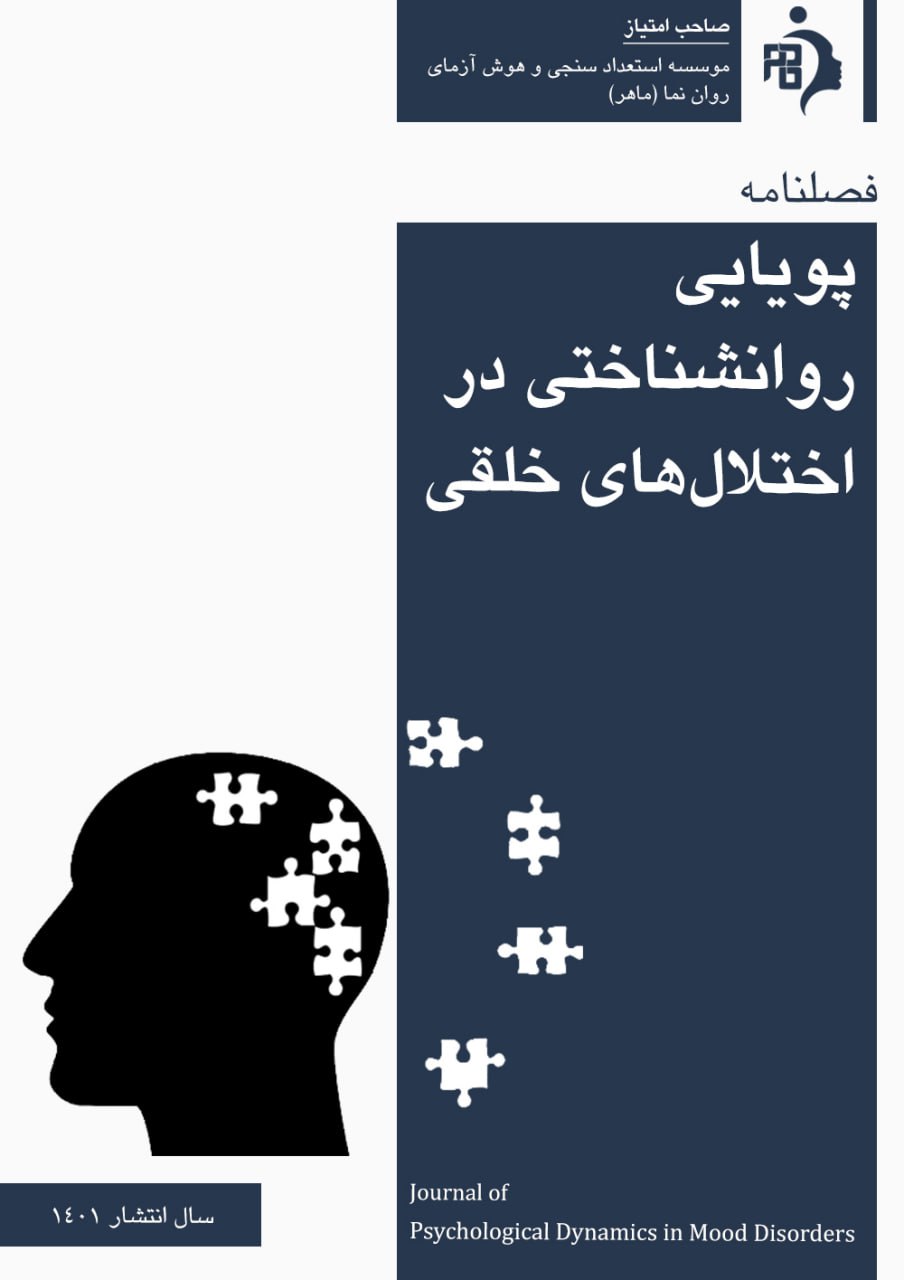The Diagnostic Validity of the Fifth Edition of the Peabody Picture Vocabulary Test in Students with Specific Learning Disorder
Keywords:
Diagnostic validity, Peabody Picture Vocabulary Test, Fifth edition, Children, Specific learning disorderAbstract
Objective: This study aimed to examine the diagnostic validity of the fifth edition of the Peabody Picture Vocabulary Test (PPVT-5) in distinguishing children with specific learning disorder from typically developing peers.
Methodology: This methodological and psychometric research included all children with specific learning disorder under the care of the Tehran Exceptional Education Organization who were referred to educational counseling centers. A total of 60 children with specific learning disorder and 60 typically developing children were selected using purposive sampling. The PPVT-5 was administered, and data were analyzed using confidence interval methods along with sensitivity and specificity coefficients to assess diagnostic validity across Forms A and B.
Findings: The results indicated that the mean scores of Form A (82.48) and Form B (83.39) differed significantly from the theoretical mean (100) by less than one standard deviation, confirming the test’s ability to distinguish between clinical and normal groups. Sensitivity and specificity coefficients for Form A were 0.85 and 0.78, respectively, demonstrating satisfactory diagnostic validity. Thus, both forms of the PPVT-5 effectively identified children with specific learning disorder.
Conclusion: The fifth edition of the Peabody Picture Vocabulary Test possesses acceptable diagnostic validity for identifying children with specific learning disorder and can serve as a reliable tool in exceptional children’s assessment.
Downloads
References
Alhamdan, A. A., Murphy, M., & Crewther, S. G. (2023). Visual Motor Reaction Times Predict Receptive and Expressive Language Development in Early School-Age Children. Brain Sciences, 13(6), 965. https://doi.org/10.3390/brainsci13060965
Arshad, T., Khan, M. A., Imtiaz, R., Ramzan, H., Tanveer, M., & Ashraf, A. (2025). Assessment of Vocabulary Development in Preschool Children Using Peabody Picture Vocabulary Test-4. Ijbr, 3(2), 174-179. https://doi.org/10.70749/ijbr.v3i2.629
Bell, N. L., Lassiter, K. S., Matthews, T. D., & Hutchinson, M. B. (2001). Comparison of the Peabody Picture Vocabulary Test-Third Edition and Wechsler Adult Intelligence Scale-Third Edition with university students. Journal of Clinical Psychology, 57(3), 417–422. https://doi.org/10.1002/jclp.1024
Besha, X. S., Spencer, R. J., & Bieliauskas, L. A. (2017). PPVT-I administration rules significantly shorten PPVT-III/IV administration. The International Journal of Neuroscience, 127(5), 412–416. https://doi.org/10.1080/00207454.2016.1186026
Bootsma, J., Campbell, F., McCauley, D., Hopmans, S., Grahovac, D., Cunningham, B. J., Phoenix, M., Camargo, O. K. d., Geytenbeek, J., & Gorter, J. W. (2023). Psychometric Properties of the English Language Version of the C-BiLLT Evaluated in Typically Developing Canadian Children. Journal of Pediatric Rehabilitation Medicine, 16(1), 71-81. https://doi.org/10.3233/prm-210101
Braga, A. C., Carreiro, L. R. R., Tafla, T. L., Ranalli, N. M. G., Silva, M. F. C. E., Honjo, R. S., Kim, C. A., & Teixeira, M. C. T. V. (2018). Cognitive and behavioral profile of Williams Syndrome toddlers. Codas, 30(4). https://doi.org/10.1590/2317-1782/20182017188
Cooper, C. (2019). Psychological Testing: Theory and Practice. Routledge. https://doi.org/10.4324/9781315391342
Costa Ribeiro, C., Abramides, D. V., Fuertes, M. G., Lopes dos Santos, P. N., & Lamônica, D. A. (2016). Receptive language and intellectual abilities in preterm children. Early human development, 99, 57–60. https://doi.org/10.1016/j.earlhumdev.2016.03.011
Di Fabio, R. P. (2013). Essentials of Rehabilitation Research: A Statistical Guide to Clinical Practice. F.A. Davis.
Dunn, D. M. (2019). Peabody Picture Vocabulary Test (5th ed.). Bloomington, MN: NCS Pearson
Dunn, L. M. (1953). College and University Programs for the Preparation of Teachers of Exceptional Children. https://eric.ed.gov/?id=ED543715
Dunn, L. M. (1957). The Effectiveness of Special Day Class Training Programs for Severely (Trainable) Mentally Retarded Children. https://catalog.hathitrust.org/Record/001974604
Dunn, L. M. (1958). Teachers of Children Who Are Mentally Retarded: Qualification and Preparation of Teachers of Exceptional Children. https://eric.ed.gov/?q=source%3A%22US+Department+of+Education%22&ff1=pubReports+-+Research&pg=19
Dunn, L. M. (1959). Peabody Picture Vocabulary Test. American Guidance Service
Dunn, L. M. (1963). Exceptional Children in the Schools. Holt, Rinehart and Winston. http://plib.azaruniv.ac.ir/Search/DocumentDetails/167580
Dunn, L. M. (1970). Peabody Individual Achievement Test Vol. I: Mathematics, Reading Recognition & Vol. II: Reading Comprehension, Spelling, General Information. American Guidance Service. https://journals.sagepub.com/doi/pdf/10.1177/002246697000400412
Dunn, L. M. (1976). Peabody Early Experiences Kit, Manual. American Guidance Services
Dunn, L. M., Chun, L. T., Crowell, D. C., Dunn, L. M., Alevy, L. G., & Yackel, E. R. (1976). Peabody Early Experiences Kit. American Guidance Service
Dunn, L. M., & Dunn, D. M. (2007a). Peabody Picture Vocabulary Test--Fourth Edition (PPVT-4). American Guidance Service
Dunn, L. M., & Dunn, D. M. (2007b). Peabody Picture Vocabulary Test (4th ed.). San Antonio, TX: Pearson Education, Inc. Guidance Service
Dunn, L. M., & Dunn, L. M. (1981). PPVT: Peabody Picture Vocabulary Test, Revised. American Guidance Service
Dunn, L. M., & Dunn, L. M. (1988). Bilingual Hispanic Children on the U.S. Mainland: A Review of Research on the Cognitive, Linguistic, and Scholastic Development. Dunn Educational Services. https://eric.ed.gov/?id=ED304274
Dunn, L. M., & Dunn, L. M. (1997). Peabody Picture Vocabulary Test (PPVT-III). American Guidance Service
Dunn, L. M., & Dunn, M. F. C. (1989). Peabody Individual Achievement Test - Revised (PIAT-R) Manual. American Guidance Service
Dunn, L. M., & Markwardt, F. C. (1970). Peabody Individual Achievement Test: Volumes I, II, and Manual (PIAT). American Guidance Service
Faramarzi, S., Kiani, M., & Lahijanian, Z. (2018). Development, validation, and reliability assessment of the Child Language Development Scale. Educational Measurement Quarterly, 8(31), 1–31. https://jem.atu.ac.ir/article_8984.html
Hashemi, S. A. (2017). Standardization of the second edition of the Reynolds Intellectual Assessment Scales (RIAS-2) among gifted school students (SAMPAD) Islamic Azad University, Science and Research Branch]. Tehran. https://journals.ut.ac.ir/article_67064.html
Kamkari, K., & Afrooz, G. A. (2019). Principles of Psychometrics and Intelligence Testing. University of Tehran Press.
Kapa, L. L., Meyers-Denman, C., Plante, E., & Doubleday, K. (2020). Predictors of Treatment Response for Preschool Children With Developmental Language Disorder. American Journal of Speech-Language Pathology, 29(4), 2082–2096. https://doi.org/10.1044/2020_AJSLP-19-00198
Lockwood, A. B., & Farmer, R. L. (2020). The Cognitive Assessment Course: Two Decades Later. Psychology in the Schools, 57, 265–283. https://doi.org/10.1002/pits.22298
Łuniewska, M., Krysztofiak, M., & Haman, E. (2024). Parental Report of Vocabulary in 3‐ to 6‐year‐old Polish Children: Reliable but Not Valid. International Journal of Language & Communication Disorders, 59(6), 2483-2496. https://doi.org/10.1111/1460-6984.13101
McLean, R. K., Tully, L. A., & Dadds, M. R. (2025). Reliability, Predictive Validity and Normative Data for the Pediatric Symptom Checklist-17 in a National Australian Sample. Australian & New Zealand Journal of Psychiatry, 59(8), 702-712. https://doi.org/10.1177/00048674251342952
Mekki, S., Nada, E., Ibraheem, O. A., & Gomaa, A. (2025). Development of Speech Intelligibility in Noise With Picture Identification (SPIN-PI) Test: A New Assessment Approach for Children With Auditory Processing Disorders. The Egyptian Journal of Otolaryngology, 41(1). https://doi.org/10.1186/s43163-025-00842-2
Pae, H. K., Greenberg, D., & Morris, R. D. (2012). Construct validity and measurement invariance of the Peabody Picture Vocabulary Test-III Form A. Language Assessment Quarterly, 9(2), 152–171. https://doi.org/10.1080/15434303.2011.613504
Pankratz, M., Morrison, A., & Plante, E. (2004). Difference in standard scores of adults on the Peabody Picture Vocabulary Test (Revised and Third Edition). Journal of Speech, Language, and Hearing Research. https://doi.org/10.1044/1092-4388(2004/054)
Pour-Etemad, H., Mousa Kazemi, M., Hooman, A., Sadeghi, M. S., & Hassanzadeh Tavakoli, M. R. (2011). Psychometric properties of the short form of the Persian Picture Vocabulary Test (PPVT-Persian). Advances in Cognitive Science. https://icssjournal.ir/article-1-358-fa.html
Quaranta, J., Darling, R., Chen, M. H., DeMartino, J., & Kozlowski, M. (2025). Development and Validation of the Pediatric Well-Being Picture Scale© Using a Mixed-Methods Research Design. Nursing Reports, 15(1), 29. https://doi.org/10.3390/nursrep15010029
Ruiter, L. d., Wen, P., & Chen, S. (2022). The Assessment of Chinese Children’s English Vocabulary—A Culturally Appropriate Receptive Vocabulary Test for Young Chinese Learners of English. Frontiers in psychology, 13. https://doi.org/10.3389/fpsyg.2022.769415
Wu, H., Liu, Q., Yu, B., Zhang, Y., Ren, D., Serdarevic, M., Liang, Z., Wang, Y., Chen, S., Zhang, K., & Chen, S. (2020). Psychometric properties of the Mandarin Clinical Evaluation of Language for Preschooler's Core Scale. Journal of Communication Disorders, 87. https://doi.org/10.1016/j.jcomdis.2020.106000
Zhou, J., Ding, Z., Zhang, M. X., Wei, X., An, W.-J., Zhu, Z., Guo, P., Qiu, L., Guo, Q., & Bai, Y. (2025). Developing and Validating Accurate Test Scale for Mandarin Vocabulary Comprehension Ability of Preschool Children. International Journal of Language & Communication Disorders, 60(6). https://doi.org/10.1111/1460-6984.70141
Downloads
Published
Submitted
Revised
Accepted
Issue
Section
License
Copyright (c) 2025 سیدعلی هاشمی, کامبیز کامکاری, سعید حسن زاده (Author)

This work is licensed under a Creative Commons Attribution-NonCommercial 4.0 International License.









